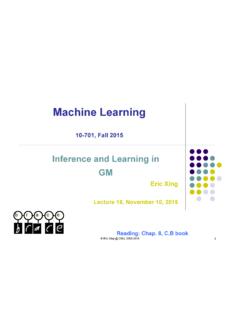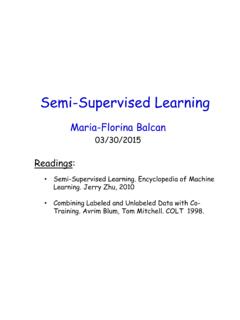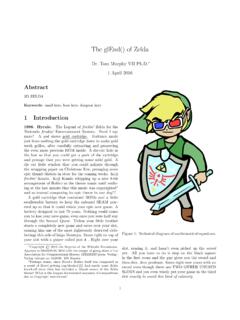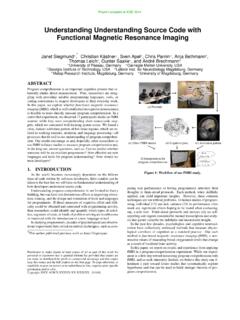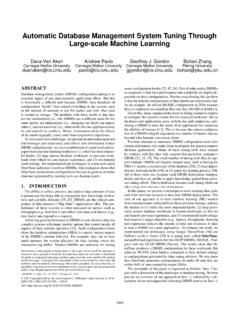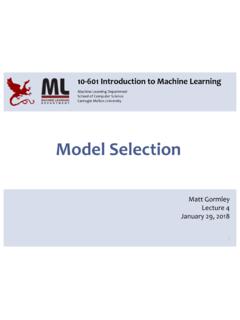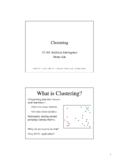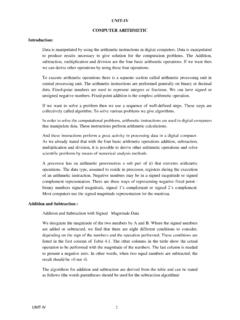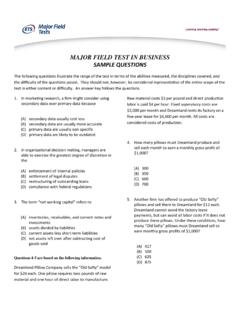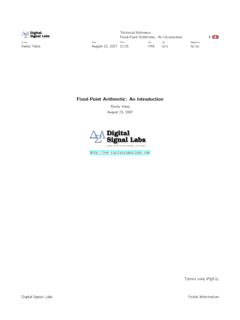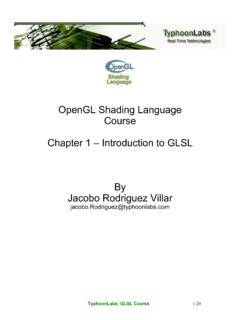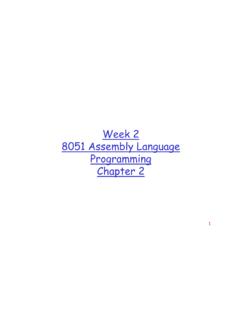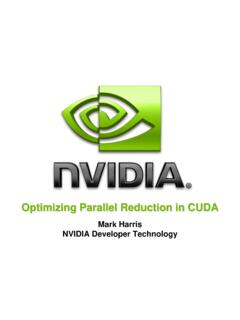Transcription of An Introduction to Arithmetic Coding
1 Glen G. Langdon, Jr. An Introduction to Arithmetic Coding Arithmetic Coding is a data compression technique that encodes data (the data string) by creating a code string which represents a fractional value on the number line between 0 and 1. The Coding algorithm is symbolwise recursive; , it operates upon and encodes (decodes) one data symbol per iteration or recursion. On each recursion, the algorithm successively partitions an interval of the number line between 0 and I, and retains one of the partitions as the new interval. Thus, the algorithm successively deals with smaller intervals, and the code string, viewed as a magnitude, lies in each of the nested intervals. The data string is recovered by using magnitude comparisons on the code string to recreate how the encoder must have successively partitioned and retained each nested subinterval. Arithmetic Coding differs considerably from the more familiar compression Coding techniques, such as prefix (Huffman) codes.
2 Also, it should not be confused with error control Coding , whose object is to detect and correct errors in computer operations. This paper presents the key notions of Arithmetic compression Coding by means of simple examples. 1. Introduction Arithmetic Coding maps a string of data (source) symbols to a code string in such a way that the original data can be recovered from the code string. The encoding and decoding algorithms perform Arithmetic operations on the code string. One recursion of the algorithm handles one data symbol. Arithmetic Coding is actually a family of codes which share the property of treating the code string as a magnitude. For a brief history of the development of Arithmetic Coding , refer to Appendix 1. Compression systems The notion of compression systems captures the idea that data may be transformed into something which is encoded, then transmitted to a destination, then transformed back into the original data.
3 Any data compression approach, whether em- ploying Arithmetic Coding , Huffman codes, or any other cod- ing technique, has a model which makes some assumptions about the data and the events encoded. The code itself can be independent of the model. Some systems which compress waveforms (eg, digitized speech) may predict the next value and encode the error. In this model the error and not the actual data is encoded. Typically, at the encoder side of a compression system, the data to be com- pressed feed a model unit. The model determines 1) the event@) to be encoded, and 2) the estimate of the relative frequency (probability) of the events. The encoder accepts the event and some indication of its relative frequency and gen- erates the code string. A simple model is the memoryless model, where the data symbols themselves are encoded according to a single code. Another model is the first-order Markov model, which uses the previous symbol as the context for the current symbol.
4 Consider, for example, compressing English sentences. If the data symbol (in this case, a letter) q is the previous letter, we would expect the next letter to be u. The first-order Markov model is a dependent model; we have a different expectation for each symbol (or in the example, each letter), depending on the context. The context is, in a sense, a state governed by the past sequence of symbols. The purpose of a context is to provide a probability distribution, or statistics, for encoding (decoding) the next symbol. Corresponding to the symbols are statistics. To simplify the discussion, consider a single-context model, , the memory- less model. Data compression results from encoding the more- frequent symbols with short code-string length increases, and encoding the less-frequent events with long code length in- creases. Let e, denote the occurrences of the ith symbol in a data string.
5 For the memoryless model and a given code, let 4 denote the length (in bits) of the code-string increase associated 0 Copyright 1984 by International Business Machines Corporation. Copying in printed form for private use is permitted without payment of royalty provided that (1) each reproduction is done without alteration and (2) the Journal reference and IBM copyright notice are included on the first page. The title and abstract, but no other portions, of this paper may be copied or distributed royalty free without further permission by computer-based and other information-service systems. Permission to republish any other portion of this paper must be obtained from the Editor. IBM J. RES. DEVELOP. VOL. 28 NO. 2 MARCH I 984 135 GLEN G. LANGDON. JR. Table 1 Example Huffman code. Encoder 136 GLEN G. L The encoder accepts the events to be encoded and generates the code string.
6 Symbol Codeword Probability p Cumulative (in binary) probability P a 0 .loo .Ooo b 10 ,010 .loo C 110 .oo 1 .I 10 d 111 .oo 1 .I 11 with symbol i. The code-string length corresponding to the data string is obtained by replacing each data symbol with its associated length and summing the lengths: c Cr4. I If 4 is large for data symbols of high relative frequency (large values of c,), the given code will almost surely fail to achieve compression. The wrong statistics (a popular symbol with a long length e) lead to a code string which may have more bits than the original data. For compression it is imperative to closely approximate the relative frequency of the more-fre- quent events. Denote the relative frequency of symbol i as p, where p, = cJN, and N is the total number of symbols in the data string. If we use a fixed frequency for each data symbol value, the best we can compress (according to our given model) is to assign length 4 as -log pi.
7 Here, logarithms are taken to the base 2 and the unit of length is the bit. Knowing the ideal length for each symbol, we calculate the ideal code length for the given data string and memoryless model by replacing each instance of symbol i in the data string by length value -log pt, and summing the lengths. Let us now review the components of a compression system: the model structure for contexts and events, the statistics unit for estimation of the event statistics, and the encoder. Model structure In practice, the model is a finite-state machine which operates successively on each data symbol and determines the current event to be encoded and its context ( , which relative frequency distribution applies to the current event). Often, each event is the data symbol itself, but the structure can define other events from which the data string could be reconstructed.
8 For example, one could define an event such as the run length of a succession of repeated symbols, , the number of times the current symbol repeats itself. Statistics estimation The estimation method computes the relative frequency dis- tribution used for each context. The computation may be performed beforehand, or may be performed during the en- Coding process, typically by a counting technique. For Huff- man codes, the event statistics are predetermined by the length of the event s codeword. The notions of model structure and statistics are important because they completely determine the available compression. Consider applications where the compression model is com- plex, , has several contexts and a need to adapt to the data string statistics. Due to the flexibility of Arithmetic Coding , for such applications the compression problem is equivalent to the modeling problem.
9 Desirable properties of a Coding method We now list some properties for which Arithmetic Coding is amply suited. For most applications, we desire thejrst-infirst-out (FIFO) property: Events are decoded in the same order as they are encoded. FIFO Coding allows for adapting to the statistics of the data string. With last-in jirst-out (LIFO) Coding , the last event encoded is the first event decoded, so adapting is diffi- cult. We desire no more than a small storage buffer at the encoder. Once events are encoded, we do not want the encod- ing of subsequent events to alter what has already been gen- erated. The encoding algorithm should be capable of accepting successive events from different probability distributions. Arithmetic Coding has this capability. Moreover, the code acts directly on the probabilities, and can adapt on the fly to changing statistics.
10 Traditional Huffman codes require the design of a different codeword set for different statistics. An initial view of Huffman and Arithmetic codes We progress to a very simple Arithmetic code by first using a prefix (Huffman) code as an example. Our purpose is to introduce the basic notions of Arithmetic codes in a very simple setting. Consider a four-symbol alphabet, for which the relative frequencies 4, i, i, and Q call for respective codeword lengths of 1, 2, 3, and 3. Let us order the alphabet {a, b, c, d) according to relative frequency, and use the code of Table 1. The probability column has the binary fraction associated with the probability corresponding to the assigned length. The encoding for the data string a a b c is IO. 110, where . is used as a delimiter to show the substitution of the codeword for the symbol. The code also has the prefix property (no codeword is the prefix of another).}
